 |
|
|
 |
 |
 |
Breed Profile
--Written By Cindy Sandhorst
--Co-Written By Tiami Coleburg

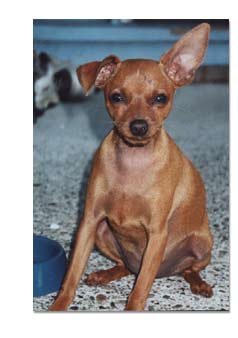 Breed: Breed:
Miniature Pinscher (also known as the Min Pin)
Owner Level:
For experienced dog owners.
Average Life Span:
Miniature Pinschers are long-lived dogs. The average life span is 14-17 years.
Average Weight:
Usual weight is 8 to 11 pounds if the dog is of correct height.
Height:
Correct Miniature Pinschers measure only 10" to 12.5" at the shoulder.
Color And Coat:
The Miniature Pinscher comes in many colors. Here are the American Kennel Club accepted colors:- Solid Clear Red: this is the most common color, varying from a dark rusty red to a color that is almost tan. Color should be rich and vibrant. A medium to dark shade is preferred.
- Stag Red: Red with intermingling of black hairs. Color should be rich and vibrant. A medium to dark shade is preferred.
- Black and Tan: Black with sharply defined rust-red markings on cheeks, lips, lower jaw, throat, twin spots above eyes and chest, lower half of forelegs, inside of hind legs and vent region, lower portion of hocks and feet. Black pencil stripes on
toes.
- Chocolate and Tan: Chocolate with rust-red markings the same as specified for blacks, except brown pencil stripes on toes.
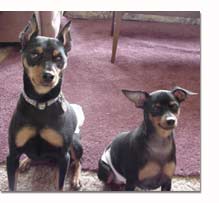 Because these dogs are small they are sometimes bred by people just out to make a dollar at the dog's and your expense, color can be a indicator of troubles to come with this breed. On puppy mill and back yard bred dogs, it is not uncommon to find white hair. It is also not uncommon to find thumb prints on the legs and no pencil marks on the toes. Also, Blue, Dilute Red and Dilute Chocolates Min Pins are showing up more and more often. Be very cautious of dogs of these colors. They cannot be shown in AKC dog shows in the confirmation ring. However, they are allowed in AKC obedience and agilty competitions. These colors are often advertised as "rare". Blues, silver, tans and dilutes are not recognized by the Miniature Pinscher Club of America.
AKC color disqualifications: Because these dogs are small they are sometimes bred by people just out to make a dollar at the dog's and your expense, color can be a indicator of troubles to come with this breed. On puppy mill and back yard bred dogs, it is not uncommon to find white hair. It is also not uncommon to find thumb prints on the legs and no pencil marks on the toes. Also, Blue, Dilute Red and Dilute Chocolates Min Pins are showing up more and more often. Be very cautious of dogs of these colors. They cannot be shown in AKC dog shows in the confirmation ring. However, they are allowed in AKC obedience and agilty competitions. These colors are often advertised as "rare". Blues, silver, tans and dilutes are not recognized by the Miniature Pinscher Club of America.
AKC color disqualifications:- Silver, tan, dilute and any color other than listed above. Blue is disqualified from the confirmation ring but can be registered.
- Thumb print (patch of black hair surrounded by rust on the front of the foreleg between the foot and the wrist. On chocolates, the patch is chocolate hair).
- White on any part of dog which exceeds one-half inch in its longest dimension.
Grooming
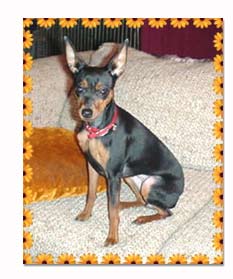 The Miniature Pinscher has a short coat, making the grooming element minimal. It is necessary to give them a good, brisk brushing every few days to ensure a clean, shiny coat. Toenails need to be trimmed at least every 2 weeks to avoid having them grow too long and cause nail-trimming to become nail-cutting: a very unpleasant experience for dog and owner. Frequent bathing is discouraged, as it tends to dry out the coat. It is better to take a warm, damp washcloth, using plain water, and wipe the dog down. Begin with the face, paying particular attention to the area under the eyes, and work back towards the tail. Done every few days, this will keep your dog clean and healthy. Make sure your dog is completely dry before a trip outside if the weather is cold. The Miniature Pinscher has a short coat, making the grooming element minimal. It is necessary to give them a good, brisk brushing every few days to ensure a clean, shiny coat. Toenails need to be trimmed at least every 2 weeks to avoid having them grow too long and cause nail-trimming to become nail-cutting: a very unpleasant experience for dog and owner. Frequent bathing is discouraged, as it tends to dry out the coat. It is better to take a warm, damp washcloth, using plain water, and wipe the dog down. Begin with the face, paying particular attention to the area under the eyes, and work back towards the tail. Done every few days, this will keep your dog clean and healthy. Make sure your dog is completely dry before a trip outside if the weather is cold.
Typical Health Problems:- Leg injuries: Because these are small dogs, it is very important to watch children around them. The Min Pin loves to run and play with kids. This easily could result in a broken leg for the dog if the child falls on it.
- Patellar Luxation is a dislocation of the kneecap (patella): The kneecap may dislocate toward the inside (medial) or outside (lateral) of the leg, or may move in both directions. It may result from injury or congenital (present at birth) deformities. Both legs may be affected.The crippling effects of patellar luxation are related to the severity and duration of the luxation. The milder forms, especially in small breeds, show little or no signs, and only minimal treatment is required. Severe cases cause more intense pain, with limping. Treatment ranges from rest (decreasing your pet's activity for 1-2 weeks) to surgical reconstruction of the knee joint.
- Legg's Perthes Disease: A condition often confused with congenital hip dysplasia. Although the final result is the same, a hip joint with arthritic and osteopoetic changes, the primary lesion is different. Legg's Perthes disease is due to the aseptic death of the head of the femur. This causes wearing and promotes arthritic changes. Thus, after the condition has progressed for some time it is difficult to diagnose whether the resulting degenerated joint is a manifestation of hip dysplasia or Legg's Perthes.This condition is congenital and has no known cure. The accompanying pain and arthritic changes can be controlled with cortisone compounds. Restricted exercise while under treatment, or during an attack of pain, is helpful. An operation for the removal of the head of the femur, thus leaving a muscle joint in the area, has proved successful for prolonging the useful life of your pet.
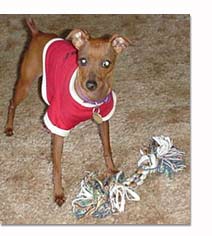 History and Personality: History and Personality:
It is believed that the Miniature Pinscher evolved from the ancient German Pinscher family of dogs, which ultimately produced a number of the breeds recognized by the American Kennel Club (AKC) today. In 1836, Dr. H. G. Reinchenbach, a German writer, stated the Miniature Pinscher is a cross of the Dachshund and the Italian Greyhound. This conclusion of Dr. Reinchenbach is now generally accepted by historians and those who have researched the background of the breed. In any event, Germany is undisputed as the home of origin, where the Miniature Pinscher was known as the "Reh Pinscher" due to its resemblance to a small red deer, the Reh, which freely roamed the German forests many years ago.
This proud little dog is often referred to as "The King of Toys". The Miniature Pinscher is an assertive, outgoing, active and independent breed. Fearless animation, complete self-possession, and spirited presence describe the Miniature Pinscher to a T.
Correct Miniature Pinschers measure only 10" to 12.5" at the shoulder, but pack quite a bit of energy into a small package! They can be incredible escape artists, hard to housebreak and obedience train, but in the right home, with the proper training, they can be the best companion dog you have ever owned. Loving, affectionate and playful, the Miniature Pinscher makes its own rules, but will bend to yours if treated with affection and care.
One of the questions that often come up in Miniature Pinscher rescue is the relation of Miniature Pinschers to Doberman Pinschers. Miniature Pinschers may have been used in the creation of the Doberman Pinscher, but it is highly unlikely. Much more likely is the probability that the two breeds are related through their common ancestor, the German Pinscher. Miniature Pinschers bear no resemblance to Doberman Pinschers in temperament. They are not miniature Dobermans, and really only have a resemblance in coloring. Head type, gait, and other conformational aspects are all completely different.
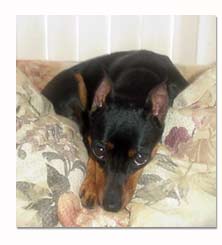 Miniature Pinschers do well on a farm or in the city. As long as they are given plenty of walks, they are happy anywhere their owners are. Although this is a toy breed, they are far from a sissy breed! On a farm the Pin will try to chase rats, mice and small varmint. Be very careful with your Min Pin. If they are off lead, they will chase anything that runs, or just run for the fun of it. They should NEVER be off lead. You will find the Min Pin to be fearless, animated, and intensely curious and always full of vim and vigor. Breeders have been quoted as saying, "It's like living with a roomful of toddlers who never grow up" and "This is not a beginner's breed". Because of their high energy levels and inquisitiveness, the Min Pin bears close watching. They need to investigate everything and will go to great lengths to do so - which includes being "escape artists". You should find dynamite in a small package or something is wrong. Rarely does anyone own "just one", as they seem to grow on you and accumulate. Plan to spend many a night when you turn off the TV because your Min Pins are putting on a much better, and funnier, show. Miniature Pinschers do well on a farm or in the city. As long as they are given plenty of walks, they are happy anywhere their owners are. Although this is a toy breed, they are far from a sissy breed! On a farm the Pin will try to chase rats, mice and small varmint. Be very careful with your Min Pin. If they are off lead, they will chase anything that runs, or just run for the fun of it. They should NEVER be off lead. You will find the Min Pin to be fearless, animated, and intensely curious and always full of vim and vigor. Breeders have been quoted as saying, "It's like living with a roomful of toddlers who never grow up" and "This is not a beginner's breed". Because of their high energy levels and inquisitiveness, the Min Pin bears close watching. They need to investigate everything and will go to great lengths to do so - which includes being "escape artists". You should find dynamite in a small package or something is wrong. Rarely does anyone own "just one", as they seem to grow on you and accumulate. Plan to spend many a night when you turn off the TV because your Min Pins are putting on a much better, and funnier, show.
Why are these dogs typically in animal shelters?
There are many reasons these little dogs end up in shelters or rescue. Some of the most common are:- Dog came in as a stray. Be very careful with your Min Pin. If they are off lead, they will chase anything that runs, or just run for the fun of it. They should NEVER be off lead.
- Failures of the owner to take the time or to correctly potty train the dog. Min Pins can be stubborn when it comes to house training. If you are consistent at a young age, they will train for life. If not, they may never be fully house trained.
- Owners have a new baby and child versus dog
conflicts.
- Excessive barking and destructive behaviors. Behaviors like this generally caused by boredom or loneliness.
- Divorce or death in the family.
- Puppy Mill raids. Many of the poor dogs rescued in these raids, have never even been in a house. Often they are in poor health from improper care and conditions.
Who should own this breed?
Although the information provided here is specific to the Miniature Pincher, it is by no means conclusive. It is highly recommended that prior to the purchase or adoption of a Miniature Pincher you do several things:- Attend as many dog shows as possible and after the judging is over spend time talking with the Breeders and Exhibitors.
- This is to be a life long companion. Spend some time and a few dollars to buy some, if not all, of the books you can find on this breed. Read and study the material and talk this over seriously with anyone else who will be involved with your dog.
A Miniature Pincher who is well cared for and properly socialized is a delight to own and will live well into its teens. This is a very long-term commitment that can be consummately rewarding if the decision is informed and well thought out. Armed with advance planning and education your decision will be the right one.
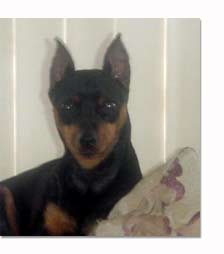 Min Pins love to snuggle with their people. They will burrow under covers to go to sleep. They are great for active adult homes. Older Pins love to be lap warmers for elderly folks. They thrive on human interaction: obedience, lap sitting, agility, walks, anything that keeps them near their people. Min Pins are not dogs that do well left alone for long periods of time. Hopefully the information provided here will enable you to decide if the "King of Toys" is meant to "Rule" in your home - and act as the resident "Court Jester" more often than not. Min Pins love to snuggle with their people. They will burrow under covers to go to sleep. They are great for active adult homes. Older Pins love to be lap warmers for elderly folks. They thrive on human interaction: obedience, lap sitting, agility, walks, anything that keeps them near their people. Min Pins are not dogs that do well left alone for long periods of time. Hopefully the information provided here will enable you to decide if the "King of Toys" is meant to "Rule" in your home - and act as the resident "Court Jester" more often than not.
Is this breed good with children?
Children and dogs should never be left alone and unattended, even for a moment. Young children do not have proper dog etiquette, and dogs do not understand a child's behavior. This can result in tragedy with any breed of dog. Like children, each dog is different in personality, energy and patience levels. So, each dog and child relationship should be considered individually.
Some Miniature Pinchers can be good with children, if the children are mature enough to be good with dogs! While this is a Toy breed, they are not toys. While Miniature Pinchers will tolerate a certain amount of attention from a child, grabbing, pinching, sudden moves and aggressiveness will be met with defensive reactions. If the Miniature Pincher is raised around children who treat them in a gentle way and are taught responsible dog ownership, they will adore children. However, if children are allowed to grab at them, hit them or treat them roughly in any way, the Min Pin will run from or bite a child. It is important to realize that even as a full grown adult, the Miniature Pincher is a very small dog. The wrong type of play and handling can easily result in broken bones and worse. Even though the Mien Pin is a bundle of energy and will bounce from sofa to chair to floor to bed...dropping one from that same sofa can easily result in unnecessary injury. Always let the Min Pin approach the child, not the other way around and you should have a wonderful companion. Patience, love and good old common sense make a great recipe for raising a Miniature Pinscher with children or adults.
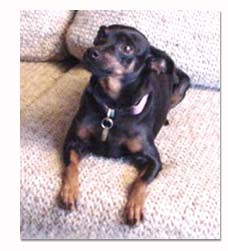 Is this breed good with other dogs in general? Is this breed good with other dogs in general?
The Miniature Pinscher if socialized and trained properly can be great with other dogs. Although they tend to be dominant breed type. You need to watch them around large dogs. Besides the fact that the large dog could hurt them by stepping on them, you need to make sure your little 10 pound dog doesn't try to put a 50 pound dog in its place! Spaying/neutering is one of the most important keys to having a dog-friendly animal. Pack position is important and will affect and vary each dog's acceptance of other dogs.
How easy is training and house training with this breed?
This breed is very stubborn, but wants to please. Once they learn something, it is in their mind forever. They make great obedience dogs and agility dogs. Because of their high energy, they do not get worn out like some other Toy breeds. A lot of Toy breed owners choose to pee/potty pad train their small dogs. This saves the owner going outside at 2 AM or in the snow. Because of the natural tendency of the Miniature Pinscher to investigate everything, it is absolutely essential that protective measures be taken in several areas. First, do not leave small objects laying on tabletops where your Min Pin can get to them. This includes paper clips, coins, lipstick, pens, etc. Be scrupulously careful to never leave any medication out and be sure to retrieve any pill or capsule you may ever drop on the floor. Otherwise you may quickly find yourself in the emergency room of your veterinarian, with your Min Pin who found it first. Secondly, you must go over every inch of any yard or outdoor space your Min Pin will have access to. If you find any hole or opening big enough to put your hand through - your Min Pin will find a way to fit through also. Fix it immediately. Additionally, make sure that any doors or windows in your home which open onto an area other than your secured yard have an extra screen, beyond what you normally have. Nothing is sadder than losing a Min Pin because he or she slipped out under your legs while you were signing for a package. Every breeder knows of this inherent danger and will gladly show you how to install special screens on doors and windows to prevent this from happening.
Socializing this breed:
Socializing this breed is very important. Like most dogs, the Miniature Pinscher should be exposed to a wide variety of fun outing experiences while safely on lead. You do need watch this little "King of Toys" carefully around other dogs. They think they are big dogs and they can get themselves into trouble. Once the Min Pin is socialized it loves to play with other dogs! Small breed dogs should be carried up out of harms way when your out around unknown large dogs to prevent injury. If socialized properly, they should have a very outgoing, playful personality. Take your dog out in public as often as you can. Pet stores are great for this. If your dog is fearful, take a pocket full of your dog's favorite treats. Let the public give your dog a treat. The more you take your dog out and let them meet new people, the better dog you will have. The "Little King of the Toy" is always looking for willing new subjects to love and adore it. |
|

